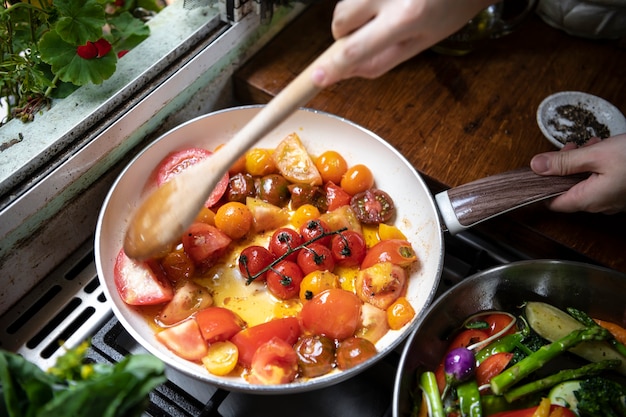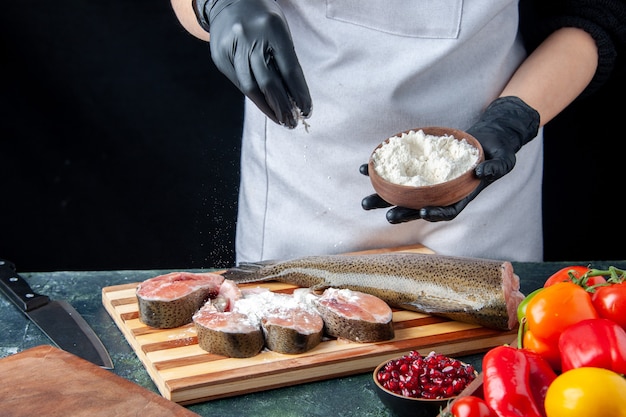Braciole. The very word conjures up images of those beautiful, rolled-up bundles of beef, simmering in a rich, fragrant sauce, just begging to be devoured. I've always been fascinated by the idea of braciole. For me, it’s more than just a dish—it's an invitation to a culinary adventure, a journey back to my Italian heritage, and a chance to create something truly special. And I'm here to guide you, step-by-step, through the process of making braciole that's not only delicious but utterly irresistible.
(Part 1) Braciole: A culinary journey

A Glimpse into History
The word “braciole” comes from the Italian word for “arm,” which gives you a hint about its origins. It originally referred to a particular cut of meat from the shoulder, but over time, it evolved into the dish we know and love today: tender, flavourful beef, stuffed with an array of delicious ingredients and rolled into an elegant, beautiful shape. Braciole has become a beloved staple throughout Italy, its warmth and aroma filling homes and gatherings with joy.
My Love Affair with Braciole
For me, braciole represents more than just a culinary tradition; it's a way to connect with my roots, to express my love for food, and to create something that brings people together. I remember the first time I tasted braciole, at my grandmother's house. The aroma that wafted from the kitchen was intoxicating, the taste a symphony of flavours, and the feeling of warmth and love, unforgettable.
(Part 2) Choosing the Perfect Beef: The Foundation of Your Braciole

Unlocking Tenderness
The foundation of any great braciole lies in the choice of beef. You need a cut that's both tender enough to roll without tearing and flavorful enough to stand up to the long braising process. My go-to choice is top round. It's lean, has a great texture, and delivers the perfect balance of tenderness and flavour. But, if you prefer, you can also use chuck roast or even a sirloin steak, ensuring it's at least 1 inch thick.
The Art of Thinning: A Key to Even Cooking
The magic of braciole lies in the transformation of the beef. We need to pound it, carefully and patiently, until it's about 1/4 inch thick. This process allows for even cooking, resulting in a tender, melt-in-your-mouth braciole. You can use a meat mallet or even a rolling pin, but remember, we're not aiming to shred the beef, just gently thin it out.
(Part 3) Building Flavor: The Heart of Your Braciole

The Classic Filling: A Symphony of Flavors
The traditional braciole filling is a delicious combination of breadcrumbs, grated Parmesan cheese, minced garlic, parsley, and sometimes chopped onions. Each ingredient plays a crucial role, the breadcrumbs adding moisture and texture, the Parmesan richness and depth, and the aromatic blend of garlic, parsley, and onion, a symphony of flavour.
Beyond Tradition: A World of Flavor Possibilities
But, why stick to tradition when the world of flavour is your oyster? I've always been a believer in exploring new possibilities, and I’ve found some incredibly delicious ways to elevate the braciole filling.
Mediterranean Twist: Embrace the sun-kissed flavours of the Mediterranean by adding sun-dried tomatoes, Kalamata olives, and a sprinkle of oregano.
Spicy Kick: For those who love a touch of heat, add some crushed red pepper flakes for a subtle but satisfying spicy kick.
Cheese Lovers Dream: Turn your braciole into a cheesy delight by using a mixture of mozzarella, provolone, and even some ricotta.
The Secret to a Perfect Filling: Balancing the Flavors
No matter which ingredients you choose, the key is to use fresh, high-quality ingredients and to make sure the filling is well-seasoned. A little salt and pepper goes a long way, and you can even add a touch of red pepper flakes for a little extra kick.
(Part 4) The Roll: Shaping Your Braciole Masterpiece
A Masterful Roll: Technique and Confidence
Once your beef is pounded and the filling is ready, it's time to roll your braciole! Lay the beef flat on a clean surface, and spread the filling evenly over it, leaving about a 1-inch border around the edges. Carefully roll the beef up tightly, like a jelly roll, and secure it with toothpicks or butcher's twine.
Achieving the Perfect Shape: A Tight Embrace
The goal is to roll the braciole tightly enough that the filling doesn't come loose during cooking, but not so tight that it becomes difficult to cut. If you're using toothpicks, be sure to remove them before serving.
The Final Touches: The Sauce that Completes the Symphony
Now that your braciole is rolled, it's time to give it the perfect sauce. You can use a classic marinara sauce or create your own masterpiece. Just ensure it's a flavorful sauce that will coat the braciole and create a delicious, rich gravy.
(Part 5) Braising to Perfection: The Art of Slow and Gentle Cooking
Patience: The Key to Tenderness and Flavor
Braising is a slow, gentle dance of cooking, allowing the beef to become incredibly tender and the flavours to meld together beautifully. Use a dutch oven or a large pot with a tight-fitting lid.
The Braising Method: A Step-by-Step Guide
1. Searing: Start by browning the braciole on all sides in a little oil. This step helps to create a delicious crust and lock in the juices.
2. Adding the Sauce: Pour your chosen sauce over the braciole, ensuring it's completely submerged.
3. Braising Time: Bring the sauce to a simmer, then cover the pot and cook over low heat for 2-3 hours, or until the beef is incredibly tender.
(Part 6) Finishing Touches: The Symphony Comes to Life
Resting: Letting the Flavors Settle
Once the braciole is cooked, let it rest for at least 15 minutes before slicing. This allows the juices to redistribute and prevents the braciole from being dry.
Serving with Finesse: The Grand Finale
I love to serve braciole with a side of creamy polenta or mashed potatoes, and a simple salad to balance the richness of the dish. A good Italian red wine, like a Chianti Classico, is the perfect accompaniment.
(Part 7) Variations on a Classic: Expanding the Horizons of Braciole
Beyond Beef: Exploring New Frontiers
While beef is the traditional choice for braciole, there's no reason why you can't use other cuts of meat, like pork loin or veal. Just be sure to adjust the cooking time accordingly.
Veggie Braciole: A Vegetarian Delight
For a vegetarian twist, try stuffing a large portobello mushroom cap with a mixture of sauteed vegetables, quinoa, and herbs. Then, wrap it in a few slices of eggplant and bake it until tender. The earthy flavours of the mushrooms, combined with the creamy quinoa and the sweetness of the eggplant, create a symphony of taste.
(Part 8) The Ultimate Guide: A Handy Table
Here's a handy table summarizing all the key steps and tips for making the most delicious braciole:
| Step | Details |
|---|---|
| Choosing the Meat | Top round, chuck roast, or sirloin steak; 1 inch thick; pound to 1/4 inch |
| Preparing the Filling | Traditional: breadcrumbs, Parmesan, garlic, parsley; add your own twists |
| Rolling the Braciole | Spread filling, roll tightly, secure with toothpicks or twine |
| Braising | Brown in oil, add sauce, simmer covered for 2-3 hours |
| Finishing Touches | Let rest, slice, serve with polenta, mashed potatoes, and salad |
(Part 9) FAQs: Your Braciole Questions Answered
1. What if my braciole is a bit dry?
If your braciole turns out a bit dry, don't despair! It's easy to fix. Simply add a little more sauce or even some broth to the pan and simmer it for a few more minutes until the braciole is moist and tender.
2. Can I freeze braciole?
Absolutely! You can freeze cooked braciole for up to 3 months. Just let it cool completely, wrap it tightly in plastic wrap and foil, and freeze it. When ready to eat, simply defrost it in the refrigerator overnight and reheat it gently in the oven.
3. What can I do with leftover braciole?
Leftover braciole is delicious! You can slice it and serve it on sandwiches with provolone and a little bit of arugula for a flavourful and satisfying lunch. It also makes a great addition to pasta dishes, salads, or even a simple cheese board.
4. Can I make braciole ahead of time?
Yes, you can absolutely make braciole ahead of time! It actually tastes better after it's had a chance to rest and the flavours have time to meld together. Simply prepare the braciole according to the instructions, but instead of cooking it immediately, cover it tightly and refrigerate it for up to 24 hours. Then, cook it as usual and enjoy!
5. How can I make my braciole even more flavourful?
For an extra punch of flavour, you can marinate the beef in a mixture of olive oil, red wine vinegar, garlic, and herbs for a few hours before rolling it. This will infuse the meat with a deep, complex flavour that will make your braciole truly unforgettable.
(Part 10) Conclusion: A culinary legacy
Making braciole is more than just cooking a meal; it’s about connecting with your heritage, celebrating food, and sharing your love of cooking with others. So, go forth and embrace the challenge. Let your creative spirit guide you, and you'll be rewarded with a dish that's sure to impress and delight. Buon appetito!
Everyone is watching

How to Cook Frozen Lobster Tails Perfectly: A Step-by-Step Guide
RecipesLobster. Just the word conjures up images of lavish meals, special occasions, and a taste of luxury. But let's...

Pork Fillet Cooking Time: How Long to Cook It Perfectly
RecipesPork fillet, or tenderloin as it's sometimes called, is a real favourite in our house. It's so versatile, and...

Pigs in a Blanket Cooking Time: How Long to Bake for Perfect Results
RecipesAh, pigs in a blanket. Just the name conjures up images of those delightful little parcels of crispy pastry en...

The Ultimate Guide to Cooking Delicious Frankfurters
RecipesLet's face it, we all love a good frankfurter. It's a classic, simple, and always satisfying. But let's be rea...

Wolf Meat Recipes: A Guide to Cooking Wild Game
RecipesLet's be honest, you don't see wolf meat at your local butcher shop every day. It's a bit of a wild card, but ...
